Pivotal Insight (GOLD)
Strategic Thinking (SILVER)
Client Credits: Ministry of Health and Long-Term Care
Client: Ontario Ministry of Health & Long Term Care
Premier’s Office, Executive Director, Marketing: Ann Byberg
Cabinet’s Office, Sr. Manager, Marketing: Sharyn Byrne-Nearing
MOH Communications & Marketing Division, Manager Marketing Communications: Monique Zarry
MOH Communications & Marketing Division, Sr. Communications Advisor: Richard Mutton
MOH Communications & Marketing Division, Project Manager, Marketing: Linda Angelakis
Agency Credits: BBDO Canada
Agency: BBDO Toronto
Chief Creative Officer: Denise Rossetto
Chief Creative Officer: Todd Mackie
VP, Associate Creative Director, Art Director: Joel Pylypiw
VP, Associate Creative Director, Copywriter: Chris Booth
VP, Group Account Director: Jennifer Jones
Account Director: Paul Forrest
Executive Producer: Dave Lembke
Strategist: Zach Kula
Production Company: Hidden Trail Media
Producer: David Stulberg
Director: Jodan Dashner
DOP: Peter Hadfield
Post House: Rooster Post
Executive Producer: Melissa Khan
Editor: Colin Murdock
Audio Houses: Cylinder Sound & Vintage Lane Audio
Section I — CASE PARAMETERS
| Business Results Period (Consecutive Months): | February 20th – June 9th 2017 |
| Start of Advertising/Communication Effort: | February 20th 2017 |
| Base Period as a Benchmark: | N/A |
| Geographic Area: | Ontario, Canada |
| Budget for this effort: | $500,000 – $1 million |
Section IA — CASE OVERVIEW
Why should this case win in the category (ies) you have entered?
To incentivize smokers to make quit attempts, we set out to transform their initial feelings on failure as a drain on motivation to being an inevitable part of the success story. This strategy resulted in more smokers seriously considering quitting as measured by behavioural change responses that exceeded our benchmark for every execution.
The key to our success came from discovering why smokers resisted making another quit attempt: they were afraid to fail again. They’d tried to quit before and their subsequent embarrassment deterred them from trying again. This insight led us to take the unexpected approach of embracing failure, which prompted viewers to reconsider their initial attitudes, leading to a discernable change in behaviour.
While anti-smoking campaigns are executed all around the world, this effort to fully embrace failure as the path to quitting was the first in any jurisdiction in the world. Its success represents a new long-term strategy for Ontario to improve health and reduce healthcare costs.
Section II — THE CLIENT’s BUSINESS ISSUES/OPPORTUNITIES
a) Describe the Client’s business, competition and relevant history:
Although the prevalence of smokers in Ontario has dropped over the past few years, the province still has 2.1 million regular and occasional smokers1. Tobacco remains the leading cause of preventable disease and premature death among Ontarians2. Since smoking rates have plateaued in recent years, there was an opportunity to revisit the province’s efforts on cessation.
b) Describe the Client’s Business Issues/Opportunities to be addressed by the campaign:
Despite significant progress in curbing the use of tobacco products, 13,000 Ontarians still die each year as a result of tobacco-related diseases3. Every year, the tobacco-related disease costs the province an estimated $2.2 billion in direct healthcare expenses and an additional $5.3 billion in indirect costs, such as lost productivity3.
Ministry-commissioned research conducted by Ipsos4 indicated that more than four-in-five regular smokers 18-34 years old thought about quitting “a lot” or “sometimes” in the past couple of months, and almost half (48%) seriously intend to quit within the next 2 to 3 months. The problem is that only a small percentage of tobacco users make an honest attempt to quit. The rest is why smoking prevalence rates have leveled off across the province. With most smoking cessation messaging catered to an older population, an opportunity existed to spark quit attempts with Ontario’s ~600,000 younger smokers aged 18-34.
c) Resulting Business Objectives: Include how these will be measured:
1. Encourage quit attempts among regular smokers aged 18-34 to help reduce Ontario’s smoking rate.
- Behaviour (IPSOS post campaign tracking5): Smokers 18-34 responding that they will “think seriously about trying to quit smoking” after seeing our message.
- Attitude (IPSOS post campaign tracking): Less smokers deterred from making quit attempts; change in perceptions surrounding quit attempts.
2. Raise awareness of the resources and support system available to those trying to quit and how to access them.
- IPSOS post-campaign tracking: increase in the number of smokers seeking out quit information after seeing the campaign.
- Increased traffic to Ministry of Health’s (MOH) smoking cessation website with above average time spent on the page using or investigating the provided resources.
SOURCES:
1 Statistics Canada. Canadian community health survey, 2008
2 Ontario Lung Association “Smoking & Health Facts” (https://www.on.lung.ca/page.aspx?pid=460)
3 Ontario News Release “A Decade of Progress Toward A Smoke-Free Ontario”, January 2015 (https://news.ontario.ca/mohltc/en/2015/01/a-decade-of-progress-toward-a-smoke-free-ontario.html)
4 IPSOS “Smoking Review Report”, April 2015
5 IPSOS “Smoking Post-Campaign 18-34 Y/O Regular Smokers”, June 22, 2017
6 Google Analytics data from cessation website (6:06 average time on site) against Google Analytics Government average Aug 2016 – Aug 2017 (1:59 average time on site)
7 Google Analytics data from cessation website (client provided)
8 PHD Post Report “Smoking Cessation – Adults 18-34”, June 26, 2017
Section III — YOUR STRATEGIC THINKING
a) What new learnings/insights did you uncover?
Everyone knows quitting smoking is hard. In fact, it’s one of the hardest things smokers will ever have to do. Data from the Canadian Cancer Society shows that to successfully quit, smokers may need to try between five to seven times. Other studies show even lower numbers. However, these studies had a glaring flaw in their methodologies: the researchers had asked former smokers to recall the number of times they had attempted to quit without considering people’s propensity to downplay their failures or the inevitability of memory decay. We discovered a new BMJ Open study which took a different approach: it analyzed data from participants in the Ontario Tobacco Survey and followed up with them every six months for three years and found an average of 29.6 quit attempts.
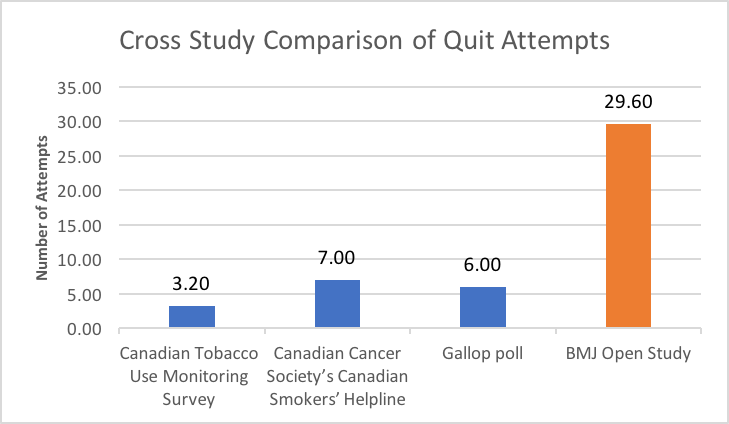
This finding led to the insight that smokers experience way more disappointment than we had initially suspected. It was an elephant in the room that strongly discouraged smokers from making additional attempts to quit. As smokers become afraid to fail again, they’re less and less likely to succeed. We needed to find a way to help them conquer this fear and encourage them to face these encounters with courage.
Our strategy was to face failure head-on and drive total reappraisal of how smokers feel about it. So whereas previously they saw it as an embarrassing weakness to be afraid of, they’d now see failure transformed into a necessary and positive action that’s necessary, normal and to be championed.
b) What was your Big Idea?
Create a new message in the “heard it all before” anti-smoking category: Embrace Failure. We welcomed the reality that attempts to quit smoking are likely to fail, but it’s okay – it’s how you quit. We took the pressure off by normalizing failure as part of the quitting process.
c) How did your Communication strategy evolve?
The communications strategy was focused on reaching our target where they’re commonly found engaging in the behavior we needed to change. 18-34-year-old smokers are hardly ever spotted out for a smoke without browsing their smartphones. This led us to a communications strategy that was primarily online with a strong mobile focus.
To drive reach and frequency, digital video played a key role in getting our target’s attention and provided a thumb-stopping option while browsing. A mobile-optimized digital display was focused on media that was attractive to this younger audience to further drive relevant online reach. A buy across Facebook and Twitter ensured we had messaging on social, which is often the first thing they check while on their smoke break. This social strategy was reinforced with influencers who each generated multiple posts to engage our target in a meaningful and personal way.
Lastly, we attained further reach by leveraging relevant outdoor space with static and digital posters placed on campuses and in resto-bars frequented by young smokers.
d) How did you anticipate the communication would achieve the Business Objectives?
The campaign was designed to address the barrier most smokers face when considering quitting – the fear of failure. By redefining attitudes around failure, we could drive reappraisal and encourage the right behaviour. If we could successfully overcome this fear, we’d get more smokers to think seriously about quitting and consider making another attempt despite previous failures.
We also believed the communication would work because it was an entirely different approach to the anti-smoking category. Smokers have heard it all before, from negative messages (“You will die!”) to superficially positive encouragement (“You can do it!”). We believed that a radically new message would have a positive effect, which proved to be true as supported by the data.
Section IV — THE WORK
a) How, where and when did you execute it?
The campaign consisted of a digital video, digital display ads, social posts on Facebook and Twitter, resto-bar and on campus OOH posters, and influencer engagement. All materials were developed with local vendors in Toronto and the campaign ran from 20 February to 4 June 2017.
c) Media Plan Summary
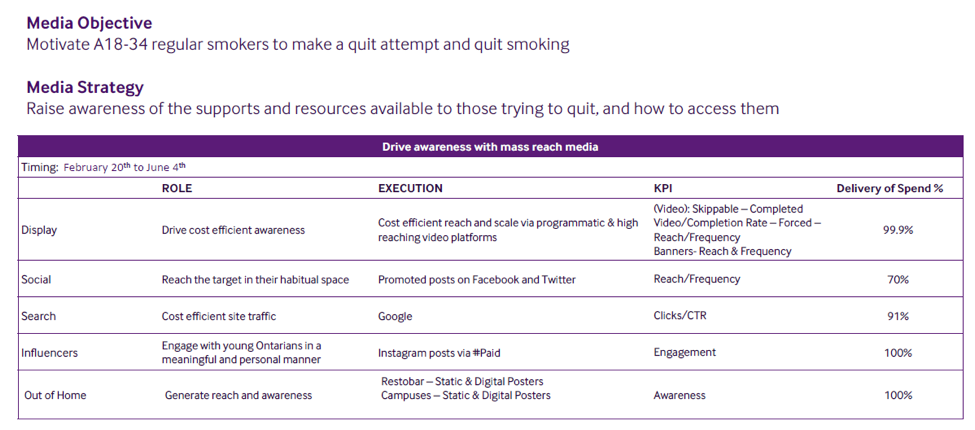
Section V — THE RESULTS
a) How did the work impact attitudes and behaviour?
Results5 showed that the perception around the actual number of quit attempts required to succeed increased following the campaign. 83% of smokers 18-34 who saw the campaign thought differently about success and failure with regards to smoking cessation. Approximately the same number (82%) of smokers 18-34 agreed that the ads make them think that a failed attempt in the future would not deter them from trying to quit again. These changes in attitude successfully influenced behaviour with 81% of smokers 18-34 who saw the campaign saying that the advertising made them think seriously about trying to quit smoking. This 81% net value for the campaign compares to a 66% benchmark for government campaign Online Banners, and 61% for government campaign TV.

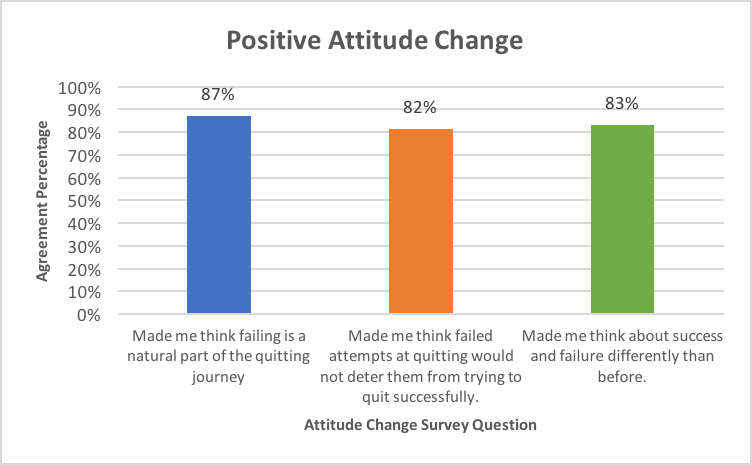
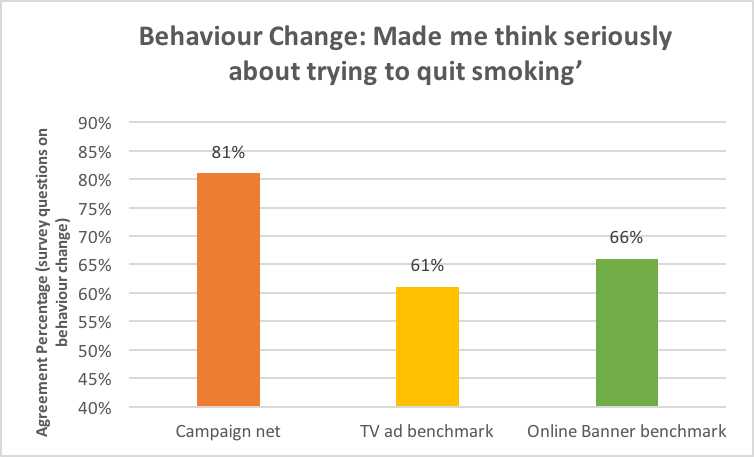
Our secondary objective was to get these smokers to seek out information on quitting that could encourage them to make another attempt. Those who saw any ads during the campaign period were significantly more likely to have deliberately sought out information on quitting that could encourage them to make another attempt (69%) compared to those who did not see any ads (38%), with the Ontario MOH cessation website cited as the most popular source of information. Those who saw any ads were also significantly more likely to have spoken to a health care provider about quitting (73%) compared to those who did not see any ads (50%). Furthermore, the average time on the Ontario MOH cessation web page during the campaign exceeded government benchmarks by 300%6. This abnormally long engagement time points to users making a sincere effort to investigate the site’s resources to prepare for a quit attempt.
With respect to quit intentions, those who saw any ads were significantly (denoted by green arrow) more likely to have thought a lot about quitting in the past couple of months (39%) and have serious intentions of quitting in the next 3 months (54%) compared those who did not see any ads (27% and 37%, respectively).
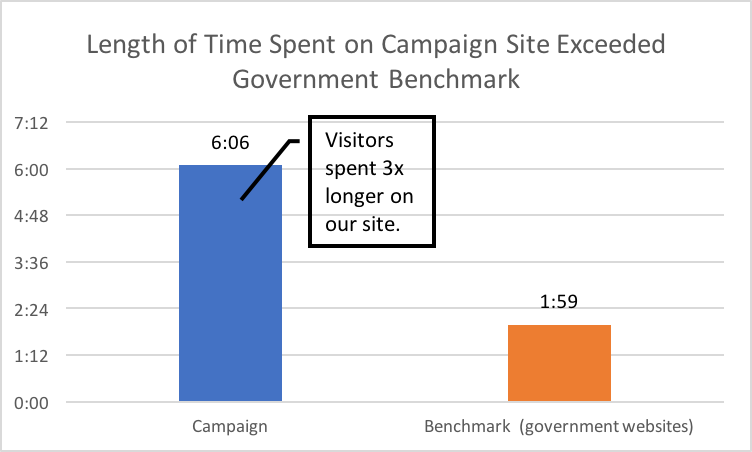


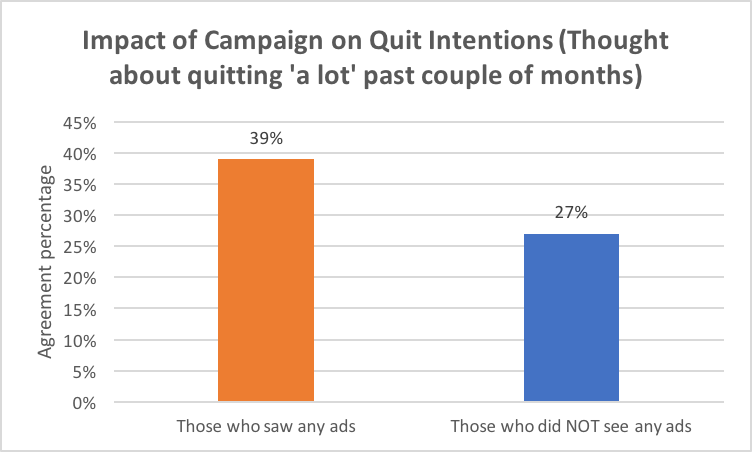
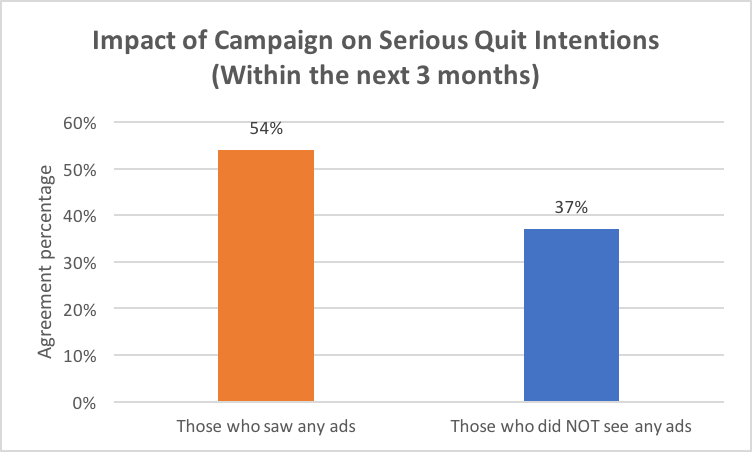
b) What Business Results did the work achieve for the client?
– Ontario MOH website cited as the most popular online information source for quitting information during the campaign period.
– Average time on the Ontario MOH cessation page of 6 mins and 6 seconds (benchmark: 1 min 59 seconds).7
– 102,363 unique pageviews on the Ontario MOH cessation page (includes English and French).7
- As compared to a target size of ~600,000.

c) Other Pertinent Results
Among those who saw the messaging, favorable reaction, the tone of the ad, message relevance, and credibility were all over 80% (in agreement), which is above the norm for government messaging.
Video Completion Rate (VCR) was 85.66% for forced views compared to the Ministry’s benchmark of 71.44%8. The skippable VCR was 26.24% for this campaign, which was well above the Ministry norm of 9.33%8.
d) What was the campaign’s Return on Investment?
A proper ROI on this case isn’t readily demonstrable since it is a behaviour change case. However, we can confidently say the effectiveness of this work demonstrates highly positive returns for the province of Ontario. Smoking-related health care costs in Ontario are estimated to be $5 billion a year. The campaign generated a 14-point lift in intention to quit among regular smokers and 1/6 of the ~600,000 target indicated serious interest in exploring quitting resources. If even 5 percent of those smokers follow through, this would equate to potential long-term savings of $35 million per year, which is more than 50x the annual cost of the campaign.
SOURCES:
1 Statistics Canada. Canadian community health survey, 2008
2 Ontario Lung Association “Smoking & Health Facts” (https://www.on.lung.ca/page.aspx?pid=460)
3 Ontario News Release “A Decade of Progress Toward A Smoke-Free Ontario”, January 2015 (https://news.ontario.ca/mohltc/en/2015/01/a-decade-of-progress-toward-a-smoke-free-ontario.html)
4 IPSOS “Smoking Review Report”, April 2015
5 IPSOS “Smoking Post-Campaign 18-34 Y/O Regular Smokers”, June 22, 2017
6 Google Analytics data from cessation website (6:06 average time on site) against Google Analytics Government average Aug 2016 – Aug 2017 (1:59 average time on site)
7 Google Analytics data from cessation website (client provided)
8 PHD Post Report “Smoking Cessation – Adults 18-34”, June 26, 2017
Section VI — Proof of Campaign Effectiveness
a) Illustrate the direct cause and effect between the campaign and the results
Impact on attitudes towards quitting:
– Before the campaign, 18-34-year-old smokers estimated that it takes an average of 5.7 times to quit smoking. Post campaign, this number more than doubled to 13.5 with statistical significance.
– All creative executions rated high on key diagnostics which show evidence that these ads illicit positive attitudes towards failure when quitting smoking, including:
- “made me think failing is a natural part of the quitting journey” (87% net agreement for the campaign)
- “made me think failed attempts at quitting would not deter me from trying to quit successfully” (82% net agreement for the campaign)
- “made me think about success and failure differently than before” (83% net agreement for the campaign)
Impact on business results:
– Proven behavioural impact; 81% of those who saw the campaign said it “made them think seriously about trying to quit smoking”
– Those who saw any ads were significantly more likely to have sought out information on quitting, spoken to a health care provider about quitting, thought a lot about quitting in the past couple of months and have serious intentions of quitting in the next 3 months compared those who did not see any ads.
– Although all sources of quitting information that were deliberately sought increased after the campaign, the Ontario MOH website increased by the largest margin with an increase of 16%.
– Those who visited ontario.ca/stopsmoking increased by 22% from pre- to post-campaign.
b) Prove the results were not driven by other factors
Campaign spend vs. history and competition:
Although we spent more this year than last, the attitude and behaviour results cited by IPSOS were strictly confined to this year’s campaign messaging.
Pre-existing Brand momentum:
While we have previously launched anti-smoking initiatives in past years, the attitude and behaviour results cited by IPSOS were strictly confined to this year’s campaign messaging.
Pricing:
Quit resources on the Ontario MOH cessation webpage have always been free for site visitors.
Changes in Distribution/Availability:
Although we targeted young smokers through more media channels than in the past, the attitude and behaviour results cited by IPSOS were strictly confined to this year’s campaign messaging.
Unusual Promotional Activity:
Although other organizations also ran anti-smoking campaigns during the tracked period, the attitude and behaviour results cited by IPSOS were strictly confined to our campaign messaging.
Any other factors:
N/A
SOURCES:
1 Statistics Canada. Canadian community health survey, 2008
2 Ontario Lung Association “Smoking & Health Facts” (https://www.on.lung.ca/page.aspx?pid=460)
3 Ontario News Release “A Decade of Progress Toward A Smoke-Free Ontario”, January 2015 (https://news.ontario.ca/mohltc/en/2015/01/a-decade-of-progress-toward-a-smoke-free-ontario.html)
4 IPSOS “Smoking Review Report”, April 2015
5 IPSOS “Smoking Post-Campaign 18-34 Y/O Regular Smokers”, June 22, 2017
6 Google Analytics data from cessation website (6:06 average time on site) against Google Analytics Government average Aug 2016 – Aug 2017 (1:59 average time on site)
7 Google Analytics data from cessation website (client provided)
8 PHD Post Report “Smoking Cessation – Adults 18-34”, June 26, 2017
